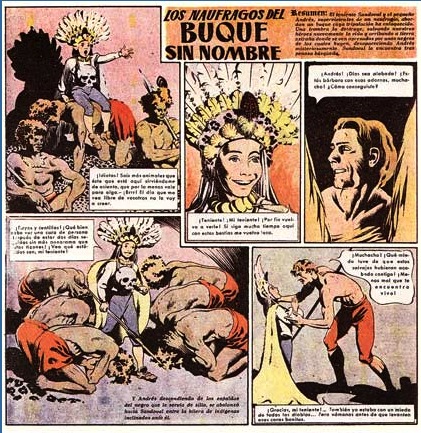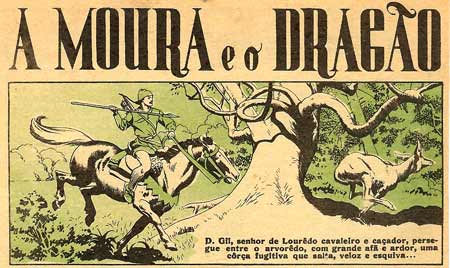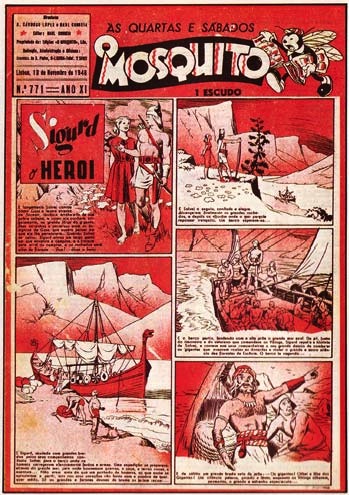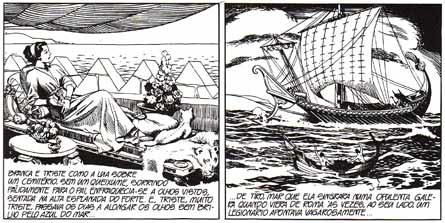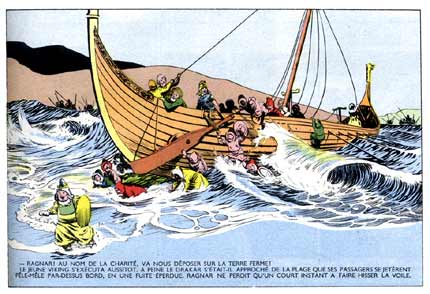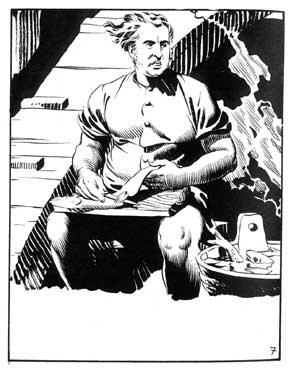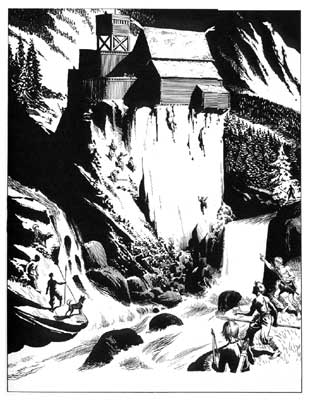Los Naufragos del Buque sin Nombre (Chicos, 1946)
After his classical studies, Eduardo Teixeira Coelho focused on making comics, which he mostly signed with only his initials, ETC, or the pseudonym Martin Sièvre. His first work appeared in the magazine Sempre Fixe in 1936 ('Há Qualquer Coisa que se Coma?!'). From 1943, he was one of the frequent contributors to the magazine Mosquito, creating comics like 'Os Guerreiros do Lago Verde' (1945), 'Sigurd o Herói' (1946), 'Falcão Negro' (1949) and the series 'O Caminho do Oriente' (1946-1948).
A Moura e o Dragão
In 1946, for A Formiga, the feminine supplement of O Mosquito, he created 'A Moura e o Dragão', 'A Moura e a Fonte' and 'A Moura e o Mar', a trilogy evoking magic and Moorish legends recurrent in Portuguese oral tradition. In these early stories Coelho already shows his master skills in depicting moving animals in an accurate and gracious way.
O Mosquito (13 November 1946)
Following his taste for legendary and historical subjects, in 1950 and 1952 Coelho illustrated stories for O Mosquito based on the work of the novelist Eça de Queirós (1845-1900), namely 'A Torre de D. Ramires' (an abridged adaptation of the novel 'A Ilustre Casa de Ramires') and 'A Aia' (an adaptation of the short story of the same name).
A Moura e o Dragão
Between 1944 and the mid-1950s, he was also present on the Spanish, Brazilian and British markets. He was a regular in Spanish magazines like Chicos and El Gran Chicos, and in Brazilian like Aventuras Heróicas and O Jornalzinho. In Britain, his work appeared in the publications of Amalgamated Press, doing mainly mainly stories with 'Robin Hood' in the Thriller Picture Library.
O Suave Milagre (O Mosquito, 1950)
In the mid-1950s, Coelho moved to France, where he started working with the magazine Vaillant (later Pif Gadget). He made several series for the magazine, like 'Ragnar le Viking' (1955-69), 'Davy Crockett' (1957), 'Wango' (1957-58), 'Yves le Loup' (1960-62), 'Robin des Bois' (1969-1974), 'Le Furet' (1975-76), 'Erik le Rouge' (1976-77) and 'Ayak, le Loup Blanc' (1979-83), mostly in cooperation with scriptwriters Jean Ollivier and Roger Lécureux. For the Vaillant press agency, he developed a humorous style for the series 'Pipolin' in 1957, and adapted the Robin Carel novel 'Les Orgues du Diable' to comics for L'Humanité.
Ragnar Le Viking (Vaillant)
In addition, from 1959, he made 'Biorn le Viking' in Pirates, and later 'Brik' (text by Jean Ollivier). He also cooperated with the publishing house Del Duca, and starting in 1964, he drew twelve stories of 'Cartouche' for Jeunesse et Vacance, as well as 'Les Gais Archers du Roi Henry'. In 1976, he collaborated on the Larousse collections 'l'Histoire de France en Bandes Dessinées' and 'Découverte du Monde en Bandes Dessinées'.
O Caminho do Oriente
In the 1980s, he illustrated various titles for Histoire Junior from scenarios by Jean Ollivier, as well as 'La Mémoire des Celtes'. He also had a passion for ancient armory and ships and published several books about both subjects. He eventually settled in Italy, where he made 'Marino, il Santo del Titano' for AEIP Editore in 1996.
Ragnar, le Viking (1958)
Coelho webpage
(in Portuguese)



